Mention you are visiting the “Lakes District”, and people instinctively think of Windermere and Coniston, Rydal Water, Ullswater and Thirlmere, Derwent Water near Keswick. But like less seen relatives, there are those of the west wing, beyond the high Honister Pass, hemmed into valleys by high fells, like the lines in your palm when you cup your hand. And they are even more spectacular than their southern cousins! Because they are a little more remote, they seem quieter and more ringed by nature, than the lakeside villages with steamboats at the quays. I speak of Buttermere and Crummock Water, Loweswater, Ennerdale Water and the curiously named Wast Water, which would be an even less favoured destination, I am sure, if an ‘e’ was added to its “Christian name!” So if you make a lake pilgrimage, go the extra mile, and you will be richly rewarded. The western lakes are truly a feast for the eyes, and the other senses simply follow.
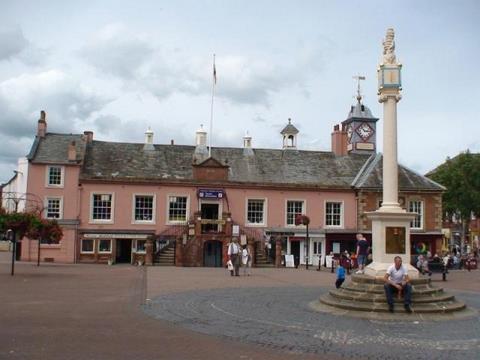
The centre of Carlisle, the northern end of the Lake District; The old Mayor’s Chambers
If England is a box of ‘plumber’s tools’, of pipes and washers, basins, taps and cisterns, and I am far too polite to say what applies where, then the historic city of Carlisle must surely be a plug. For centuries, it has sat astride the key route north, or south, depending on your nationality, and each ‘invader’ has had to ‘take Carlisle’ before moving on. The Romans made it a key point in the year 1 AD, and after that, there was a procession of kings and armies, bent on taking Carlisle castle and its walled town. All the usual suspects, Henry’s and James’, Wallace and the Bonnie Prince, even Mary, She of Scots, spent prison time there. It was a continuous cycle of battery, repair, decay, repair, battery, so that up to the late Twentieth Century, the Castle was an active military fort, built around a massive Norman keep and bailey. Command houses inside the fort still bear the names of places where soldiers of the Border Regiment fought, Ypres, Gallipoli, Arnhem, and there is a wonderful, if crowded, exhibition on the 1944 Battle of Arnhem.
Carlisle today is the main centre of Cumbria, a city with modern suburbs and a historic heart, which has been turned into a wonderfully broad pedestrian area full of ‘olde wolde’ shops and restaurants, but plenty of places with bling as well. There is an abundance of parkland, and lots of solid policeman-type houses, stout without being flash. But on the outskirts, there are leafy lanes and a lot of large and expensive houses. From the Castle ramparts there were wonderful views up to Scotland, and down to the Fells, and Carlisle struck me as a good place as a base to explore the Western Lakeland. But we were already booked in some forty miles further south, and we joined the peak hour throng to leave the city centre.
We passed through Cockermouth, a pleasant, ancient market town, with broad tree-lined streets. It has all the historic attributes, an old castle ruin, lovely Georgian slate and stone architecture, cobbled streets, a high-spired church, plus the added bonus that Willie Wordsworth was born there in 1770 (and later, Dottie too!). It is a quiet place with serene views to the Fells although locals told us that sometimes it resounds to the burble of rally cars as the Ford Rally Team have their workshops nearby. And then there is the annual "Cock Rock" music festival! In recent times, it has also had its share of tragedy; in late 2009 a devastating flood, in June 2010, gunshots by a deranged man.
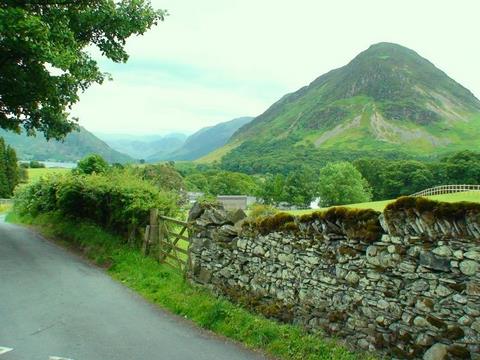
Country road in the Western Lake District near Crummock Water
As it was late, we pressed on, down little 'hands, knees and boom-sa-daisy’ roads, so close to homes that you would swear you'd be invited in for tea and "Coronation Street"! Always the road went over little becks, through dells and fields full of sheep, everywhere looking out at the brooding Fells. We went past a red phone box, then the country church with its weathered gravestones that no longer told the names of those buried there, and made a sharp turn. And there it was, love at 'first right', the whitewashed walls, black framed windows, and yellow painted doors of the Kirkstile Inn. We swooned, for it was small and angular, alone on a slight ridge in a haven of green fields, a brook at its feet, simply tranquility personified! "Cute" said my wife, even before she had breasted the bar, or ensured the cleanliness of the facilities, and she happily led the way into the Inn's cozy interior. Grey clouds gathered, and the first drops spattered on the slate roof, but we were warm and dry. There would be no going out to dine tonight!
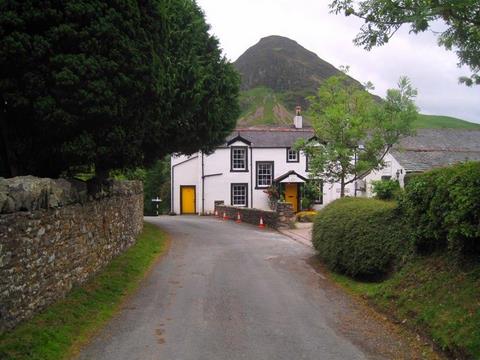
The Kirkstile Inn at Loweswater under brooding Mellbreak Fell
In a culinary caper, I have already told you about the Kirkstile Inn and its wonderful food and snug accommodation, but apart from the hospitality, it was its sheer isolation that we found so engaging. It was as though we were at an outpost, yet in reality, swinging Cockermouth was less than a dozen miles away. The roads are so narrow and twisting that you simply cannot hurry, even when you want to get somewhere quickly! You simply have to slow down. Even in the pubs, real ale has to stand before you can drink it, and you soon learn that in this place, you cannot hurry nature. Here the sheep plod and the cows amble, for only the very young and foolish saunter or gambol! And it is only in these places, that you truly appreciate that towns are there to complement nature, and not vice versa. They become a place to drive to for a coffee, and to browse in the shops, a ‘reassurance’ possibly, of some form of ‘civilization’, but for true peace of mind, the beauty of the Fells and the lakes is something you can stare at endlessly. It is indeed, food for the soul for here, mind and limbs cannot fail but relax. Even that driving spirit of the dollar, as in “We’ve paid a lot of money to get here, now we have to go out and see something”, doesn’t wash anymore. I am by nature, restless, but here I found myself slouching on a couch, reading a book, with the occasional glance out of the window at the mountain scenery for sustenance, and I felt entirely sated. Here too, I could wander lonely as a cloud, and feel rejuvenated.
Lazily, we set out the next morning, many hours after my usual start time, and when a car came up behind us, I searched for a place to let it past for this was a day we wanted to spend at ‘our pace’, to see and to savour. Last night’s rain now flowed down the Fell-sides in sliver streaks, groping for new paths, the only sign of anything rushing. The road to Buttermere tracked through tussocky pasture, and the backdrop of bald slopes, yet full of black-faced Herdwick sheep and their generally black woolly lambs. At times there were dangerous drops beside the road, with nary a safety fence, but at our pace, it held little fear and sometimes the back-packing Fell walkers seemed to be travelling at a greater speed than we were! Like them, we also stopped frequently to look about us at the views. Indeed, that was probably our most exhausting activity!
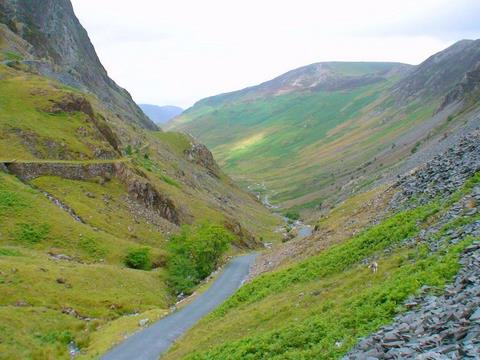
The Honister Pass, for our trip from the Western Lakes to Keswick
We climbed the Honister Pass, with healthy rabbits frequently darting across the road, inches from our wheels, as though they thought, probably from my gentle pace, that Beatrix Potter herself was at the wheel and that there might be room for a few literary extras! At the top of the Pass, there was a slate mine which offered trips underground, and a place to “Fill Yer Boot for Five Quid”, and I don’t think they were talking Wellingtons! Having previously been to such a dank, dripping mine once before in Wales, we happily scooted down the other side of the Pass, and headed for Keswick, via the stately hotels of Borrowdale, at one end of Derwent Water. The road was indeed busier, the woods darker, and the lake full of kayakers and little yachtees, almost as though Honister Pass was a step too far towards the badlands beyond. I was secretly glad that so many had stayed on this side of the Lakes divide, and only a few shared our haven.
Keswick is a key town, not so much another plug, but as a sort of funnel with a number of spouts in the form of slick fast roads to whisk you south to Grasmere, east to Penrith or north to Carlisle. You simply find it easier to ‘go via Keswick’ and the fair (I use it in a pigment sense) keepers of Keswick, all have those killer “come on in” smiles! Pretty, with spouting flowers, stout of stone and slate of course, a wide market oblong, with a market hall and its clock perpetually stuck at 10.55 at one end, it is all wall to wall shops, pubs, and tea-rooms. Amid the humdrum of chintz, beads, and dooverlacky shops, there are some very ritzy and exclusive places, yet all banged in together, like urchins sidled up beside Coco Chanel. And as in the other Lakeland towns, there is one outdoor shop after another in that “I got my Anorak in Ambleside, but my crampons in Keswick,” sort of way! The parking fees are as steep as some of the Fells, so a steady turn-over is assured, and people flock to Keswick en masse, to eat, and to buy. And not just the tourists, for we saw plenty of ladies in Barbours, wicker basket on their arm, and men in ‘shooting jackets’ and deer stalker hats, both with that thousand-yard “over the crowd’s heads” stare, the obligatory Pointer on a lead, who leapt lithely into the Lexus. Everyone was very friendly, the cream tea superb, and in the sun trap where we sat, you could almost believe it was summer.
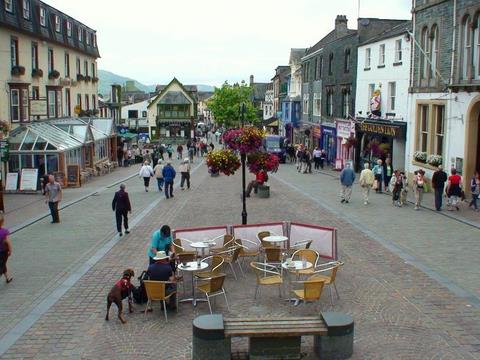
The Main mall in Keswick
We drove that afternoon to Maryport, on the Atlantic coast. Once the Romans had been there, but we understood why they left. The tide was out and the vast acres of mud and sea-weed stank, despite the best efforts of a cleansing gale from across the Irish Sea which turned the distant waves into cappuccino froth. Bloated sea-gulls wheeled above us and I quickly got back into the car lest one was on a bombing run, then we drove along an industrialized coastline of containers and cranes, chimneys, and wind turbines on the nearby hills. When we turned inland again, towards the mouth-filling village of Lamplugh, we felt as though we had been given absolution.
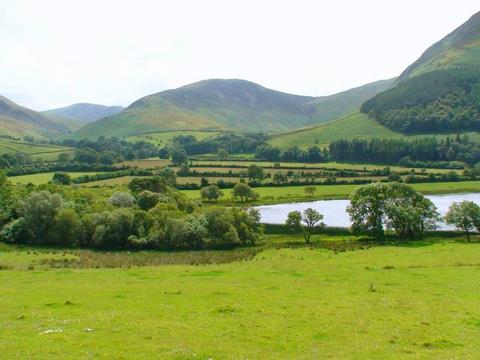
The countryside around Loweswater
The next morning, after a breakfast fit for a burgher and large enough to feed the whole Council, we packed the little Vauxhall Clio for the last time, and headed west again, to the dirty sea and the sty, grubby little towns clustered along the road ‘outa there’. In just fifteen minutes, we went from fabulous to forlorn, delightful to dismal, Workington, Whitehaven, Egremont, and Calder Bridge, all ‘working towns’. At Ravenglass, the countryside became pretty again and Munster Castle, which claims to be the most haunted castle in England, was beautifully set, while near Broughton in Furness we were again in the area of the southern Lakes. But now the M6 called us.
We stopped briefly in the ‘Red Rose’ City of Lancaster, drawn by the huge cupola of the Ashton Memorial, Baron Ashton’s memory to his second wife, the Taj Mahal of the North. ‘Swinging Lancaster’ said a sign, which I thought referred to it being a major university city, but instead it was because more hangings had happened at its gaol, other than in London! There were indeed, some wonderful eighteenth and nineteenth century buildings, as well as a few from earlier periods, and the Lancaster Castle, with bits dating from medieval times, was still a working prison. The Queen too, I learned, was also the Duke of Lancaster, and that many of her properties were in the Duchy. But now we were ready to head home, and we lingered only for a lager in the gardens of a cute country pub before making our way to Manchester Airport on the M6 and its derivatives. Hours later, we were aboard and again “Spam in the can”. Lovely England was left behind us, although for the next six hours, it wasn’t just the fabulous memories we squeezed in!
Winfred Peppinck is the Tales of the Traveling Editor for Wandering Educators.
All photos courtesy and copyright Winfred Peppinck
